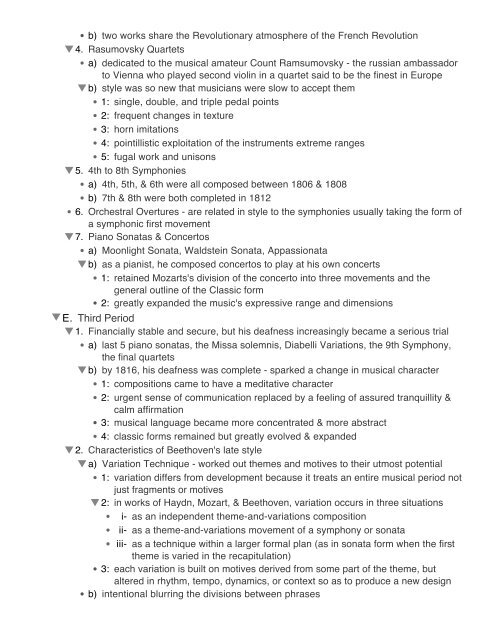An Outline of The History of Western Music Grout ... - The Reel Score
An Outline of The History of Western Music Grout ... - The Reel Score
An Outline of The History of Western Music Grout ... - The Reel Score
You also want an ePaper? Increase the reach of your titles
YUMPU automatically turns print PDFs into web optimized ePapers that Google loves.
) two works share the Revolutionary atmosphere <strong>of</strong> the French Revolution<br />
4. Rasumovsky Quartets<br />
a) dedicated to the musical amateur Count Ramsumovsky - the russian ambassador<br />
to Vienna who played second violin in a quartet said to be the finest in Europe<br />
b) style was so new that musicians were slow to accept them<br />
1: single, double, and triple pedal points<br />
2: frequent changes in texture<br />
3: horn imitations<br />
4: pointillistic exploitation <strong>of</strong> the instruments extreme ranges<br />
5: fugal work and unisons<br />
5. 4th to 8th Symphonies<br />
a) 4th, 5th, & 6th were all composed between 1806 & 1808<br />
b) 7th & 8th were both completed in 1812<br />
6. Orchestral Overtures - are related in style to the symphonies usually taking the form <strong>of</strong><br />
a symphonic first movement<br />
7. Piano Sonatas & Concertos<br />
a) Moonlight Sonata, Waldstein Sonata, Appassionata<br />
b) as a pianist, he composed concertos to play at his own concerts<br />
1: retained Mozarts's division <strong>of</strong> the concerto into three movements and the<br />
general outline <strong>of</strong> the Classic form<br />
2: greatly expanded the music's expressive range and dimensions<br />
E. Third Period<br />
1. Financially stable and secure, but his deafness increasingly became a serious trial<br />
a) last 5 piano sonatas, the Missa solemnis, Diabelli Variations, the 9th Symphony,<br />
the final quartets<br />
b) by 1816, his deafness was complete - sparked a change in musical character<br />
1: compositions came to have a meditative character<br />
2: urgent sense <strong>of</strong> communication replaced by a feeling <strong>of</strong> assured tranquillity &<br />
calm affirmation<br />
3: musical language became more concentrated & more abstract<br />
4: classic forms remained but greatly evolved & expanded<br />
2. Characteristics <strong>of</strong> Beethoven's late style<br />
a) Variation Technique - worked out themes and motives to their utmost potential<br />
1: variation differs from development because it treats an entire musical period not<br />
just fragments or motives<br />
2: in works <strong>of</strong> Haydn, Mozart, & Beethoven, variation occurs in three situations<br />
i- as an independent theme-and-variations composition<br />
ii- as a theme-and-variations movement <strong>of</strong> a symphony or sonata<br />
iii- as a technique within a larger formal plan (as in sonata form when the first<br />
theme is varied in the recapitulation)<br />
3: each variation is built on motives derived from some part <strong>of</strong> the theme, but<br />
altered in rhythm, tempo, dynamics, or context so as to produce a new design<br />
b) intentional blurring the divisions between phrases<br />
c) improvisatory character <strong>of</strong> some passages give some idea <strong>of</strong> his actual<br />
improvisations at the piano





